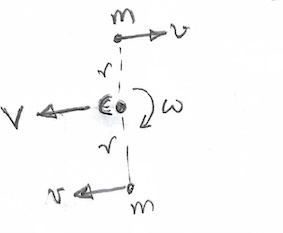I saw the formula relating the kinetic energy of the system, which is $$K \ \text{(of system)} = K \ \text{(of centre of mass)} + K \ \text{(about centre of mass)},$$ where $K$ is the kinetic energy.
If I consider a disc rotating about its centre with some angular velocity and moving with linear velocity $v$, the kinetic energy of the centre of mass is $1/2 \ Mv^2$.
If we go into the centre of mass frame (which is similar to the case that we are sitting on the centre of mass and seeing the motion of all the particles of the disc), we see that nothing is moving, so the kinetic energy about the centre of mass is zero. But it is written in the books that it is $1/2 \ I \omega^2$. Why?
I think I am wrong about thinking about the centre of mass frame telling where I am (I'm just analysing the motion by sitting on the centre of mass so that I am rotating with it).
Also, tell me what are the expressions for the kinetic energy about centre of mass frame and the kinetic energy of centre of mass frame by correcting me.
Tell me if I am wrong anywhere and misunderstanding the concept. Please explain to me clearly.


